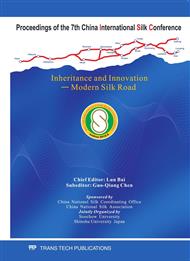p.85
p.90
p.95
p.100
p.105
p.110
p.116
p.121
p.127
Preparation and Antibacterial Activity of Poly (vinyl Alcohol)/Silk Fibroin Composite Nanofibers Containing Silver Nanoparticles
Abstract:
Silk fibroin (SF) and polyvinyl alcohol (PVA) solutions were prepared respectively by formic acid and deionized water as solvent, the solutions were then blended, and after that AgNO3 was added. The PVA/SF/AgNO3 solution was electrospun to form nanofibers. A number of particles were generated on the surface of nanofibers during electrospinning, which was confirmed by transmission electron microscopy (TEM). The diameter distribution of the nanofibers was narrow and the particles were nano-sized and well-dispersed. X-ray diffraction (XRD) patterns of the composite nanofibers indicated that the component of the nanoparticles was silver. By annealing the composite nanofibers at 155°C for 5 minutes, the silver nanoparticles possibly clustered into the larger size. The size of Ag nanoparticles was 2.25nm without post treatment, and this value increased to 3.76nm after the heat treatment. The antibacterial activity of the heat-treated PVA/SF composite nanofibers containing Ag nanoparticles was evaluated and the resultant nanofibers showed strong antimicrobial activity on Staphylococcus aureus and Escherichia coli. Moreover, the antibacterial PVA/SF composite nanofibers containing Ag nanoparticles have the possibility to be used in wound dressing due to the electrospun PVA nanofibers could preserve the web structure in water after the heat treatment.
Info:
Periodical:
Pages:
105-109
Citation:
Online since:
January 2011
Authors:
Price:
Сopyright:
© 2011 Trans Tech Publications Ltd. All Rights Reserved
Share:
Citation:


